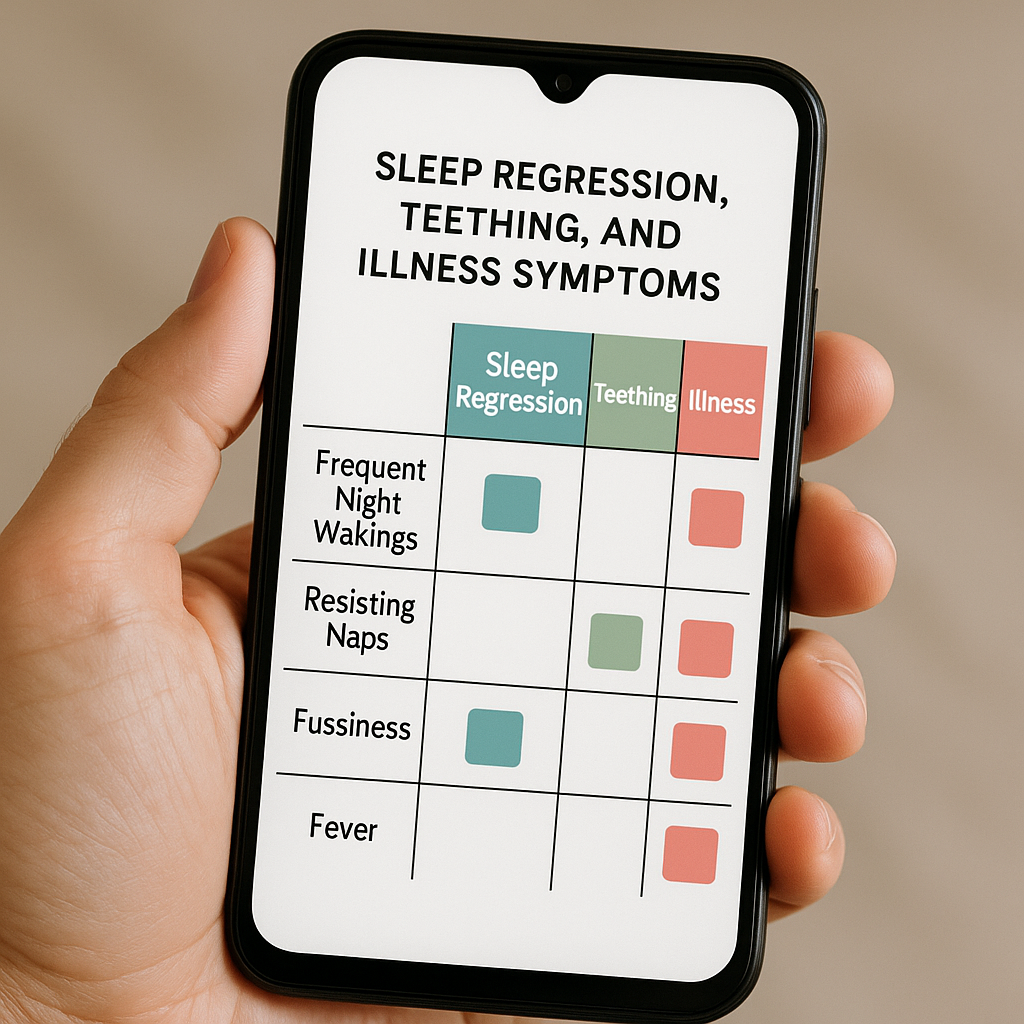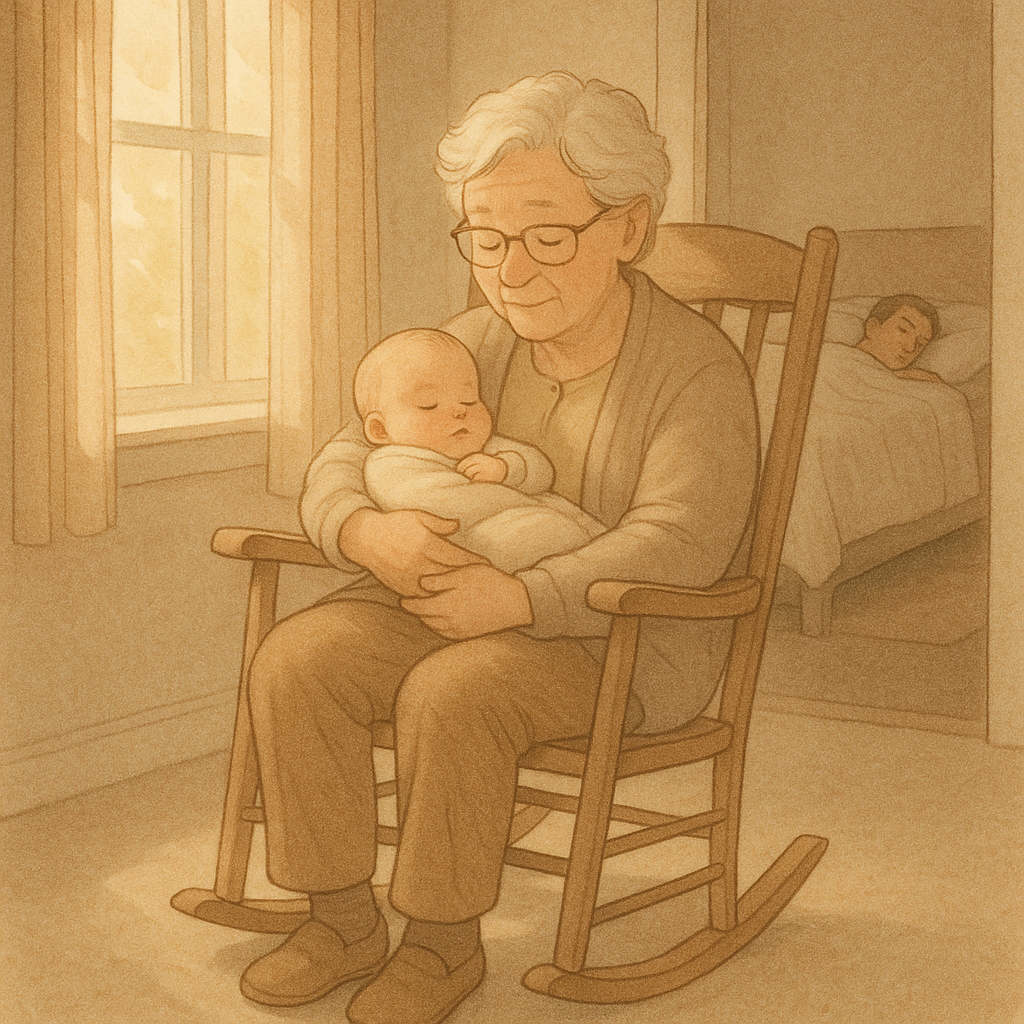Up to 80 % of babies who master a new skill wake every two hours—welcome to the sleep regression. Many parents notice their once-peaceful sleeper suddenly waking frequently at night or resisting naps, which can be exhausting. Research suggests these regressions are not setbacks but signs of brain maturation, driven by the rapid cognitive and physical growth babies experience in their first few years. Let’s have a look at it in detail:
- What exactly is a baby sleep regression—and is it really a setback?
- Why do sleep regressions happen in the first place?
- When do sleep regressions usually strike—and what milestone lines up each time?
- How long do sleep regressions last—and can you shorten the storm?
- Is it a regression, teething, or illness? How to triage at 2 a.m.
- Which coping strategies calm a regression fastest?
- How do you build a sleep foundation that buffers future regressions?
- Can sleep regressions be prevented or predicted?
- What about preemies, high-need infants, or unique family setups?
- When should you call a professional about sleep troubles?
- Your Top Questions, Answered
- Final Thoughts
What exactly is a baby sleep regression—and is it really a setback?
Baby sleep regressions are temporary periods of disrupted sleep, typically lasting 2–6 weeks, marked by frequent night waking, shorter naps, or fussiness. These disruptions often coincide with developmental milestones, such as rolling or language acquisition, reflecting brain maturation processes like synaptic pruning and neural connection formation. Pediatric sleep specialists often refer to it as a “progression” ( signs of cognitive progress) rather than a regression(setbacks), as the brain strengthens pathways in areas like the hippocampus for memory consolidation.
In most cases, regressions occur multiple times in the first three years, though some babies with consistent routines (20-25%) experience milder symptoms, depending on temperament. This highlights individual variability in sleep responses. Far from a step backward, these periods show your baby’s brain is growing—potentially influenced by factors like gut microbiota, which emerging research links to cognitive health. Understanding this helps parents stay calm during disrupted nights, setting the stage for strategies like sensory play to support both sleep and development.

Why do sleep regressions happen in the first place?
Sleep regressions occur primarily due to brain maturation and developmental milestones that disrupt sleep patterns. Around 4 months, a baby’s sleep architecture shifts to adult-like cycles, alternating between light and deep sleep every 90–120 minutes. These transitions increase wake-up risks as the brain forms neural connections and undergoes synaptic pruning. Common triggers, supported by research from the Sleep Foundation, include:
- Motor Milestones: Babies practice skills like rolling or crawling (e.g., at 6–10 months), activating motor cortex development.
- Cognitive Surges: Learning object permanence, experiencing language bursts (e.g., at 12–18 months), or developing vivid imagination in toddlers can interrupt sleep patterns.
- Emotional Growth: Separation anxiety, peaking at 10–18 months, heightens emotional development, leading to clingy wake-ups.
- Environmental Factors: Factors like travel, illness, temperature changes, or skipped naps can exacerbate sleep disruptions.
Learn more about sleep’s role in brain development in How Sleep Supports Baby Brain Development.
When do sleep regressions usually strike—and what milestone lines up each time?
Sleep regressions typically occur at specific ages, aligning with developmental milestones that drive brain maturation. The table below, based on pediatric research, outlines common regression periods, their associated milestones, and parental observations, reflecting neural connection formation and synaptic pruning:
| Age | Developmental Milestone | Parental Observations |
|---|---|---|
| 4 months | Sleep cycle maturation, rolling | Frequent night wakings, 30-minute naps |
| 6 months | Sitting, introducing solids | Early morning wake-ups, night hunger |
| 8–10 months | Crawling, object permanence | Standing in crib, separation anxiety |
| 12 months | Walking, first words | Nap transitions, bedtime resistance |
| 15–18 months | Language surge | Nighttime calls for parents |
| 2 years | Independence, early imagination | Bedtime stalling, new fears |
| 3 years | Complex imagination, storytelling | Nightmares, requests for company |
Not every child hits every regression, and temperament matters. Align new wake windows with the chart in Baby Sleep Needs by Age.
How long do sleep regressions last—and can you shorten the storm?
Most sleep regressions resolve in 2–4 weeks, though the four-month shift is a permanent change in sleep patterns, marking a transition to more adult-like cycles. Research suggests babies with bedtimes between 7:00–8:00 p.m. often rebound faster, though specific studies linking bedtime to recovery speed are limited. To help your baby recover more quickly, try these strategies:
- Maintain a predictable bedtime routine: A sequence like bath, story, and crib, performed nightly, cues melatonin release, stabilizing sleep cycles.
- Ensure age-appropriate nap lengths: For example, 1–2 hours twice daily for a 6-month-old prevents overtiredness, aiding memory consolidation.
- Encourage daytime skill practice: Allow 10–15 minutes for activities like rolling or babbling to reduce nighttime rehearsals, supporting synaptic pruning.
- Expose your baby to natural daylight: 30 minutes of sunlight after lunch anchors the circadian clock, enhancing sleep regulation.
- Create a calm sleep environment: Keep the room dark, cool (68–72°F / 20–22°C), and use white noise to minimize disruptions.
These strategies support neural wiring and cognitive growth, though outcomes can vary based on individual baby needs.
Is it a regression, teething, or illness? How to triage at 2 a.m.
Compare your baby’s symptoms to distinguish between a sleep regression, teething, or illness for effective nighttime triage. The table below, informed by pediatric guidelines from the American Academy of Pediatrics, helps identify the cause based on onset, behavior, and additional signs:
| Clue | Regression | Teething | Illness |
|---|---|---|---|
| Onset | Sudden, tied to milestones (e.g., rolling at 4 months) | 24–72 hours before tooth eruption | Anytime, often with rapid change |
| Night Wakings | Frequent, playful or clingy | Whiny, seeking objects to chew | Inconsolable, restless |
| Other Signs | Practicing new skills (e.g., crawling) | Drooling, swollen gums | Fever ≥ 100.4°F / 38°C, cough, or lethargy |
Rule of thumb: If sleep improves after three days of pain relief (e.g., acetaminophen), suspect teething; if disruptions persist beyond two weeks without illness symptoms, it’s likely a regression. For regressions, maintain consistent routines to support neural connections and synaptic pruning, which are active during milestones. For illness, consult a pediatrician if fever or lethargy persists. Always ensure a safe sleep environment—review guidelines in Safe Sleep Practices for Baby Brain Health.

Which coping strategies calm a regression fastest?
Use consistent routines and environmental adjustments to calm sleep regressions quickly. Research suggests the following strategies, which support neural regulation and reduce regression intensity, typically within 2–4 weeks:
- Maintain a consistent bedtime routine: A predictable sequence, like bath, book, and crib, cues melatonin release, aiding sleep cycle stability.
- Wait Before Rushing In: Wait 60 seconds to allow your baby to self-soothe, fostering independence and minimizing disruptions to neural consolidation.
- Encourage daytime skill practice: Dedicate 10–15 minutes to activities like crawling or stacking blocks to reduce nighttime rehearsals, supporting motor skill development.
- Optimize the sleep environment: Use blackout curtains, white noise, and a cool room (68–72°F / 20–22°C) to enhance circadian rhythm alignment.
- Share responsibilities: Alternate nighttime duties with a partner or family member to prevent parental burnout, which can elevate cortisol levels.
Need a step-by-step evening plan? Visit How to Create a Sleep Routine for Better Baby Brain Health.
How do you build a sleep foundation that buffers future regressions?
Create consistent sleep routines to buffer future regressions by maintaining a fixed wake-up time within 30 minutes daily, adhering to age-appropriate wake windows, and prioritizing naps. Regular naps, such as 1–2 hours for a 6-month-old, support memory consolidation and strengthen neural connections in the hippocampus, reducing the intensity of regressions, according to PubMed: Infant Sleep and Brain Development.
Gradually adjust schedules (e.g., shift bedtime by 15 minutes every three nights) to avoid disrupting your baby’s circadian rhythm. Additionally, incorporate sensory play, like 10–15 minutes of textured toys daily, to stimulate cognitive growth and minimize nighttime skill practice as per Sleep Foundation: Baby Sleep.
For detailed nap strategies, visit Naps Boost Baby Memory.
Chronic overtiredness spikes cortisol, making regressions rougher—learn more in Overtired Baby? How Lack of Sleep Harms Brain Growth.
Can sleep regressions be prevented or predicted?
While sleep regressions cannot be prevented, parents can often spot signs early, such as increased babbling, pulling to stand, or longer wake windows, which often appear a week before sleep disruptions. These cues reflect brain maturation, such as synaptic pruning. Families who co-sleep might miss early cues or experience regressions more intensely, suggesting a need for tailored strategies. Focus on mitigation rather than avoidance, aligning with research on developmental variability. Explore pros and cons in Co-Sleeping vs. Crib: Best for Your Baby’s Brain?.
What about preemies, high-need infants, or unique family setups?
For preemies, use their adjusted age to time regressions, ensuring accurate milestone tracking. High-need babies may benefit from slower routine changes and extra calming techniques like swaddling or white noise, supporting their unique needs. In single-parent or multi-generational homes, creative duty swaps (e.g., a grandparent handling dawn duty) can protect parental sleep, aligning with research on family dynamics and sleep health.

When should you call a professional about sleep troubles?
Seek help if disrupted sleep lasts beyond six weeks, your baby shows weight loss, breathing issues, or loud snoring, or you feel overwhelmed. Persistent night wakings paired with developmental delays warrant a pediatric or sleep-medicine referral. Parents facing burnout should reach out—chronic sleep loss increases postpartum depression risk. Compare gentle methods in Sleep Training vs. Night Wakings.
Your Top Questions, Answered
-
Should I start sleep training during a regression?
Stick with what’s already working; wait to introduce a brand-new program until sleep stabilizes. Maintaining familiar cues prevents confusion while your baby rides out the phase. -
Will rocking to sleep once ruin our progress?
An occasional rescue rock won’t undo good habits. Just return to normal routines the next night so the exception doesn’t become the rule. -
What is the 5-3-3 rule everyone mentions?
It’s a gradual check-in technique: wait 5 minutes, then 3, then another 3 before soothing again. Many parents use it after 4 months to encourage self-settling. -
How can I tell a regression is ending?
Longer sleep stretches, fewer protests, and smoother naps for three straight days signal the storm is passing. Celebrate—and keep routines tight. -
Do formula-fed and breastfed babies regress differently?
Timelines are the same; only hunger management differs. Ensure full daytime calories so night wakings aren’t fueled by genuine hunger.
Final Thoughts
Sleep regressions are a natural part of your baby’s development, signaling their brain is growing and learning. By maintaining consistent routines, encouraging daytime skill practice, and being patient, most families can navigate these periods successfully.
Remember that sleep is crucial for brain development, supporting memory consolidation, neural connection formation, and overall cognitive growth. Additionally, factors like nutrition and sensory play also play a role, as research suggests gut microbiota can influence cognitive outcomes, offering a lesser-known insight into baby brain health. With these strategies, you can help your baby—and yourself—get the rest you need, aligning with a holistic approach to infant development.